Promoing diversity & inclusion and Health management
Diversity & Inclusion
Through our efforts in promotion of diversity and inclusion, we are committed to creating a company where diverse employees are empowered and feel proud and fulfilled.
Basic policy
Our basic policy for diversity and inclusion is to create a company where diverse employees are productive, perform at their best, being empowered, and feel proud and fulfilled. We are reinforcing various efforts with a focus on the following five areas, as one of the important management issues.
- Promotion of women’s participation and career advancement
- Realizing the work life balance as a means to enable employees with diverse situations perform well in the workplace
- Health management aimed for employees to work at their best up to the age of 65
- Preventing harassment
- Empowerment of older people and persons with disabilities
As a dedicated unit to promote these efforts, the Diversity & Inclusion Department has been established. Its staff reports the progress of various efforts, the work engagement score as a general index, and other matters to the Management Committee and other committees every year.
Status of employees (non-consolidated basis)
| Men | Women | Total | |
|---|---|---|---|
| Number of employees (March 31, 2024) | 25,721 | 2,822 | 28,543 |
| Number of new hires (April 2024) | 645 | 104 | 749 |
| Average years of service (March 31, 2024) | 18.0 years |
13.5 years |
17.6 years |
| Average age (March 31, 2024) | 40.3 years old |
35.6 years old |
39.9 years old |
| Turnover rate1 (FY2023) | 1.7% | 3.8% | 1.9% |
1 The rate of voluntary retirees to all employees
Promotion of women’s participation and career advancement
What we have done so far
We have endeavored to establish a comfortable working environment for female employees. Specific programs include: 1) a childcare leave benefit which is more generous than legally required; 2) a program for employees who rejoin the Company after having left it because of childcare or nursing care and other reasons; 3) a leave option to assist overseas relocation of a spouse; and 4) a temporary exemption program for employees who have difficulty in relocation because of childcare or nursing care and other reasons. We have also been opening 24-hour childcare centers in steelworks and provide maternity work clothes for use by steelwork employees who are in the childbirth/childcare phase, in order to help them continue their shift work with confidence. We are also working to improve the workplace infrastructure such as showers, toilets, and dressing rooms at manufacturing sites, and to improve the work content.
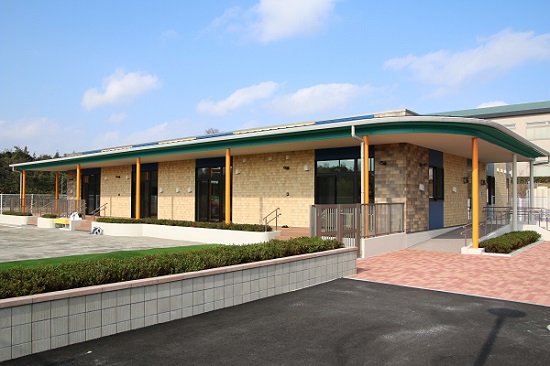
In-house childcare center (East Nippon Works Kashima Area)
| Internal childcare centers (As of April 2024) |
7centers |
|---|---|
| Users of internal childcare centers (As of April 2024) |
139 |
Based on the various programs and work environments that we have established, we have developed an action plan, which includes a numerical target for the number of women in management positions. Our aim is to support female employees to continue to demonstrate their abilities through career development, and to promote their empowerment in all workplaces and levels, including enhancement of promotion to managerial positions.

Plan of action as a general employer, based on the Act on the Promotion of Female Participation and Career Advancement in the Workplace in Japan
In order to develop an employment environment where female employees can perform at their best, an action plan is formulated as follows:
- Plan period: 5 years (April 1, 2021–March 31, 2026)
- Goals, details of efforts, and implementation schedule
Target1
From FY2021
- Hire more women.
- Confirm the individual circumstances and intentions of female employees and consider placement and development measures based on their circumstances in order to enable them to continue to work and actively perform.
- Invest in the working environment so as to expand the placement of women, mainly at steelworks (improvement in work infrastructure, work content, etc.)
- Consider and implement work support measures for employees in the childcare status period, such as measures for childcare centers that offer night-time service.
- In light of the enhancement of the programs related to childbirth and childcare, prepare a brochure to introduce the relevant programs, distribute it to employees, and revise related programs as needed.
- Provide career education that will contribute to the further promotion of female employees’ performance.
- Provide education on diversity to managers who supervise female employees.
Target2
From FY2021
- Prepare a pamphlet on the vacation and leave program, distribute it to employees, and develop educational activities.
- Encourage taking paid leave days by setting with the labor union some specific days recommended for paid leaves and by conducting a campaign to do so in the summer.
- Managers to take the initiative in taking off on paid leave days.
- Managers to support each employee to take paid leaves as scheduled.
| 2022 | 2023 | 2024 | |
|---|---|---|---|
| Number of female employees in management positions (As of April) |
55 | 65 | 70 |
| FY 2021 |
FY 2022 |
FY 2023 |
|
|---|---|---|---|
| Utilization rate of paid leave days | 77.8 %2 |
82.9 % |
86.2 % |
2 Including the effects of temporarily suspended operation to reduce production in response to a major drop in steel demand
Improved hiring and retention
We have been working to hire a greater number of women to promote their participation and career advancement. We are encouraging remote working to facilitate a shift to a flexible workstyle and to reduce long work hours so that those with a constraint on the workplace or work time due to childcare or other conditions can continue to work. Career assessments for female employees have been conducted to facilitate flexible placement and development based on the understanding of individual circumstances and to improve retention rates.
At the same time, we will continue to make changes to enhance the working environment, including improvement of the environment for expanding work placement for women especially in steel mills, and the operation of childcare centers that can also be used during the nighttime.
| The ratio of women in overall hiring (2024) |
Office staff and engineers 25% Operators and maintenance personnel 11% Overall hiring 14% |
|---|
Support for employees’ career development and work-life balance
We encourage female employees to develop and show their abilities by providing them with opportunities for career growth through efforts in anticipation of their various life events, and by actively promoting their advancement to managerial positions. For staff, as a training measure for the promotion of managers, we have newly established two-way online seminars for young employees with the aim of interacting with female senior employees, and career training for mid-level employees. For operators and maintenance staff, we started exchange meetings for female team leaders from different steelworks/areas in fiscal 2021. This provides an opportunity for female team leaders to share their workplace challenges and concerns and find clues to a resolution.
We are creating a workplace culture where work and home life are comfortably balanced by supporting employees in various ways, including improving and disseminating brochures explaining the relevant programs and guides for employees facing life events as well as for their managers. We also provide to managers training concerning unconscious bias and diversity management.
| FY2021 | FY2022 | FY2023 | |
|---|---|---|---|
| Childcare leave acquisition rate among eligible male employees (a combined rate of male employees taking childcare leave and those taking childcare-purpose paid holidays) |
25% (81%) |
56% (100%) |
66% (100%) |
Realizing the work life balance as a means to enable people with diverse situations perform well in the workplace
Restraint on long-work hours
As a precondition for an environment in which diverse employees can perform at their best, we are committed to reducing long work hours based on appropriate work time management. We are promoting improved work management and work practices that lead to more efficient, higher-value-added output. In addition, we had set a goal of less than 2,000 hours on average for the total annual actual working hours, and have achieved it.
We will continue to pursue workstyles that achieve maximum results within a limited amount of time, while incorporating the effects of business reform and DX measures.
Enabling flexible ways of working
All employees with their diverse attributes and circumstances ideally should make the most of their finite time available and perform at their best. From this viewpoint, we are expanding our work system to pursue more flexible and diverse ways of working. Specifically, we are utilizing the remorte work system and expanding workplaces that use the “coreless flexible system,” which eliminated the core time — an essential time period to work. In April 2024, we expanded the system for employees who are assigned unaccompanied, and revised the system to enable flexible working for employees who use shorter working hours for childcare, nursing care, etc. we aim to achieve improved productivity and employees’ work-life balance, while pursuing ways in which individuals can perform at their best.
Realization of a flexible way to take time off from work
We have been establishing the environment for our employees so that it facilitates a flexibility in the ways to take time off from work, tailored to the circumstances of individual employees and their life stage.
Annual paid holidays can be taken on a half-day basis to meet employees’ needs. Each of our steelworks and offices designates dates on which employees are encouraged to take holidays. The head office, for example, sets mainly Fridays in August, as “Eco-paid leave days” and recommends making it easier for employees there not needing to attend meetings and other events on those days to take off.
Concerning childcare leave, in addition to providing a longer period than the statutory limit, the expired annual leave days accrued by each individual can be recovered to paid off-days for parental leave. In addition, from the viewpoint of encouraging child-rearing male employees to actively participate in childcare, we are focusing on clarifying the corporate policies, fostering a workplace culture that encourages employees’ use of the system, and promoting the use of childcare leave and childcare-related leave benefits by all male employees whose spouses have given birth to take childcare leave and childcare-related leave on an individual basis.
Performance of ways of working and taking time off (FY2023)
| Average overtime hours per worker per month | 23.6hours |
|---|---|
| Utilization of paid leave days | 86.2% |
| Average paid leaves taken | 17.2days |
| Childcare leave users and utilization rates |
675 men (66%) 176 women (100%) |
| Return ratio of female employees after childcare leave | 99.0% |
| Number of users of the short-work hour program for childcare | 128 |
| Nursing care leave and vacation program users | 23 |
| Users of the short-work hour system for nursing care | 3 |
Matched to the ongoing aging of Japanese society, programs for nursing care leave and time off for nursing care have been established to help employees continue working while attending to nursing care. The expired leave days that have been accrued can be used for nursing care purposes, as part of our efforts to provide an environment in which employees can work with peace of mind while providing care.
The expired annual leave days can also be utilized for such purposes as prenatal checkups and recurrent (relearning) education, in addition to childcare and nursing care, sick leave, care of elementary to junior high school children, volunteer work, and infertility treatment. For recurrent education, we have established a leave system for obtaining a degree at a university or another educational institution.
In April 2024, we changed the name of menstrual leave for women to “F-Care leave,” and revised it to make it possible to leave on a half-day basis.
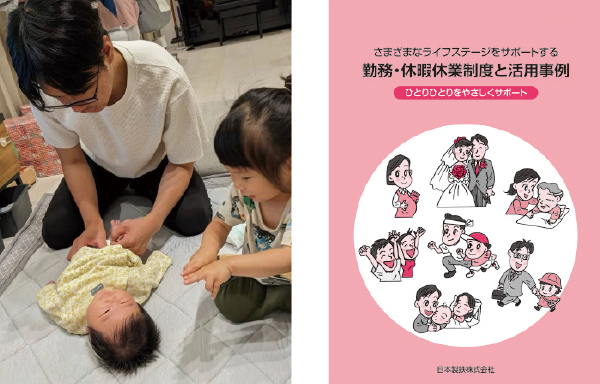
To promote the use of these programs, we distributed a brochure that summarizes each type of work and vacation program applicable for each life stage. We try to make the programs better known through various training programs.
Benefit programs
In order to support the various life stages of employees and enable them to achieve a good work-life balance, we are also focusing on welfare measures. We support employees’ personal life with various programs: provision of housing, including dormitories and company housing, and a cafeteria plan (work-life support program).
Health management aimed for employees to work at their best up to the age of 65
Basic policy
Embracing the basic philosophy of Nippon Steel’s Basic Policy on Safety and Health, our basic policy of health management is to become a vibrant company in which all employees maintain both mental and physical health and work at their best from the time of joining the company to retirement, which has been extended to the age of 65. We are committed to providing advanced health checkups including cancer or mental disorder screening and encouraging employees to get regular checkups and provide consultation or counseling about lifestyle or stress coping by health care professionals, as needed. Employees are expected to also be committed to implementing measures for their own health maintenance, such as getting various checkups and improve their daily lifestyle. We believe that such efforts by both the Nippon Steel Group and its employees become a source of motivation for work. They are encouraged to balance their work and health and they try not to get sick and, in case they get sick, they continue working while undergoing treatment.
Nippon Steel Corporation Group Code of Conduct
5 Create a healthy, safe, and comfortable work environment, and respect the character and diversity of our employees.
Nippon Steel’s Basic Policy on Safety and Health
Basic Philosophy
- Ensuring and maintaining the safety and health of employees of the Nippon Steel Group is the Group’s most important, top-priority values and the basis that supports business development.
- Under the Management Principles of “developing and bringing out the best in our people,” the Nippon Steel Group makes continuous efforts to abide by this philosophy and continues to contribute to society through their safety and health.
Specific Guidelines
- We observe applicable laws and regulations, and give top priority in all business decisions to ensuring safety and health.
- We maintain awareness and understanding of actual workplace conditions, provide the guidance needed to ensure safety and health, and remove factors that might lead to accidents.
- We follow plans to implement measures to realize safer, healthier work procedures and work environments.
- We ensure the observance of rules and engage in hazard prediction, and proactively implement workplace activities to enhance the level of safety and health.
- We provide the education and training needed to ensure the safety and health of people working in the Nippon Steel Group.
- We continuously develop and improve safety and health efforts through the safety and health management system.
April 1, 2019
President of Nippon Steel Corporation
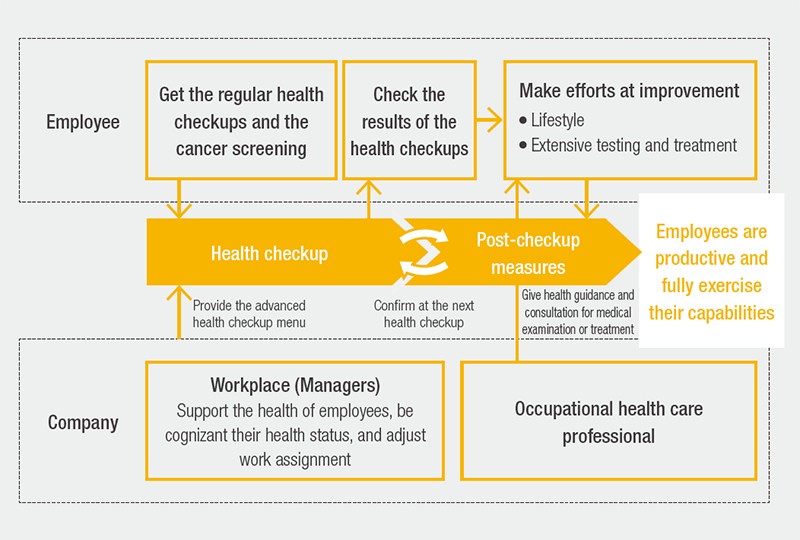
Commitment to the health of both the Company and its employees
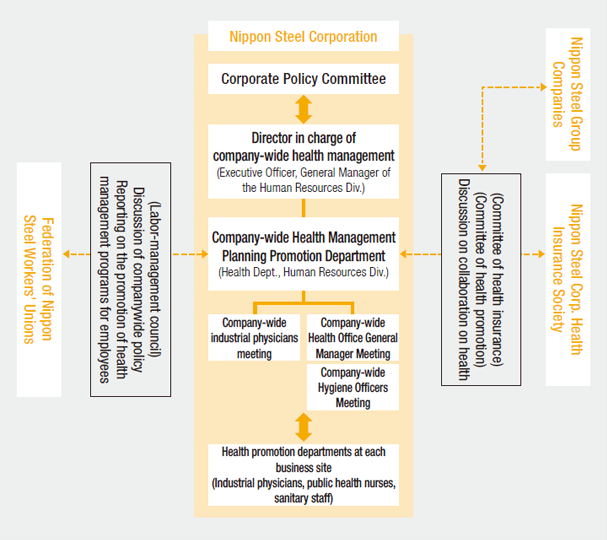
Organization for health promotion
Promoting physical wellness
We have established a unique company-wide system that enables us to assess and manage the risk of diseases based on the results of health checkups. We provide health guidance according to risk factors or control the frequency of health checkups.
It is important that workers with high risk of cardiovascular disease improve their lifestyle. We will improve the implementation rate of specified health guidance, which aimed at improving the dietary and exercise habits of workers, by setting a target rate and promoting medical visits. We cooperate with the Health Insurance Union for achieving the goal.

Various cancer screening (including non-statutory exams) based on age and gender are incorporated in our health checkups.
In particular, regarding exams for gastric and colon cancer, which are high risk diseases, we set the evidence-based priority target age and screening frequency for the examination. We also set our target rate of exam-taking and encourage employees to take exams for early detection and treatment of cancer.
| Type of examination | Priority target (target age and test frequency) |
|---|---|
| Gastric cancer examination (gastric fluoroscopy) | Once every 2 years, 50-years old or older |
| Colorectal cancer test (fecal occult blood) | Once a year, 40-years old or older |
| Prostate cancer test (PSA) | Once every 3 years, 50-years old or older |
| Breast cancer screening (mammography) | Once every 2 years, 40-years old or older |
| Cervical carcinoma of the uterus (uterine cytology) | Once every 2 years, 20-years old or older |
| Gastric cancer risk test (pylori) | When joined the company and at 40 |
| Liver cancer risk test (hepatitis virus) | When joined the company and at 40 |

Promoting mental wellness
Aiming for each employee in the Nippon Steel Group to enjoy a vigorous life on and off the job, we provide a consulting service for prevention and early detection in the area of mental health. We have incorporated the issue of mental health in various in-house seminars and offer education on how to be aware of one’s own stress and to deal with it. For managers, we additionally offer education on how to care for their subordinates and manage their teams, and how to coordinate with the corporate health care professionals (occupational physicians, health nurses, and other staff). Moreover, we provide stress checks through a workplace stress survey every fall. Occupational health care professionals give guidance for improvement by teams and individuals based on the result of the stress check. In contributing to a vigorous work environment, managers implement necessary measures according to the issues of a team or an individual, coordinating with the personnel department and the health department. Because early detection and early response are important in the treatment of mental illness, we identify those who are at risk at the Health Consulting Contact by various measures in association with the Company’s mental health e-learning and questionnaire event conducted every June. Occupational health care professionals swiftly respond to the findings of the events to foster mental wellbeing.
Our mental health initiatives
On smartphones, swipe sideways to use.
| Classification | Details | |
|---|---|---|
| Proactive action | (Self-care) |
|
| (Care by management supervisors) |
|
|
| (Care by occupational health care professionals) |
|
|
| Early detection |
|
|
| Support for employees' return to jobs and prevention of recurrence |
|
|
Support to employees who work overseas
To enable employees who have been assigned to work overseas to be free of undue worries, a seminar for the employees and their family is held before the overseas assignment, and information on mandatory vaccination, the local medical system, and other matters are provided. Under the policy of providing continuous health management support during overseas assignments, interviews with occupational health care professionals are regularly conducted counseling via online and at the time of a temporary return to Japan, in addition to aftercare checkups of the regular medical exams. Moreover, one of the Company’s physicians periodically visits overseas offices, researches local medical institutions and the daily-life environment, and meets with the employees who work overseas to offer advice. We have contracted with a medical service company to provide the medical care locally, in preparation for the employees possibly becoming ill overseas.
In the event of another pandemic, necessary infection prevention measures, including evacuation measures, based on what we have learned from responses to COVID-19, have been implemented in consideration of the local infection situation and the state of medical care, with the first priority on the safety and health of the employees who work overseas and their families.
Health-wellbeing activities
In addition to the above-stated health measures, we collaborate with the Health Insurance Union and labor unions in a variety of health-wellbeing activities, such as the “Health Challenge Campaign” living habits, “Health e-learning” for improving employee health awareness, and passive smoking preventive measures.
On smartphones, swipe sideways to use.
| Classification | Details |
|---|---|
| Health Challenge Campaign |
|
| Passive smoking preventive measures and non-smoking guidance |
|
Preventing harassment
We are strengthening efforts to prevent harassment in order to create an environment where diverse human resources can work diligently with peace of mind.
We have clarified our internal policies, created and disseminated leaflets to inform and enlighten all employees, and repeatedly provided education on harassment in training at employees’ milestones, from new employees to managers. From fiscal 2020, in addition to these initiatives, we are conducting a “Harassment Prevention Campaign” every December. In the campaign, we offer e-learning and self-checks for all the employees and board members, and workplace dialogue specifying themes such as creating an open workplace.
Dedicated consultation and reporting points of contact have been established for employees who face a harassment issue.
Each of the contact points responds to each individual case while paying attention not to disadvantage anyone for reporting or cooperating. After investigating and confirming the existence of a problem, we take strict measures in accordance with employment rules and other regulations.
Empowerment of the elderly and the disabled
Employment for the elderly
Concerning promoting the empowerment of older people, we have decided to raise the retirement age from 60 to 65 in fiscal year 2021. This change reflects the decline in the working population and the raising of pension eligibility age, and was made also from the perspective of maintaining and enhancing our on-site manufacturing capacity.
Under this system, hopefully, all generations, up to 65 years of age, will continue to perform at their best at the front lines of our workplaces, while also invigorating the skill transfer process and communication within the workplace between generations, thereby creating a vibrant company.
Employment for the disadvantaged
Recognizing employment of the disabled as an important social challenge, we are implementing an action plan for their employment and providing a friendly working environment.
Since 2007, we have established special-purpose companies to further expand employment opportunities. At our special subsidiaries, over 100 people are actively engaged mainly in outsourced work from Nippon Steel. The various work includes data input and printing of written documents, cleaning of the steelworks premises, cleaning and management of the welfare facilities, and cleaning of work clothes.
| Employment rate of persons with disabilities (June 2024) |
2.63% |
|---|
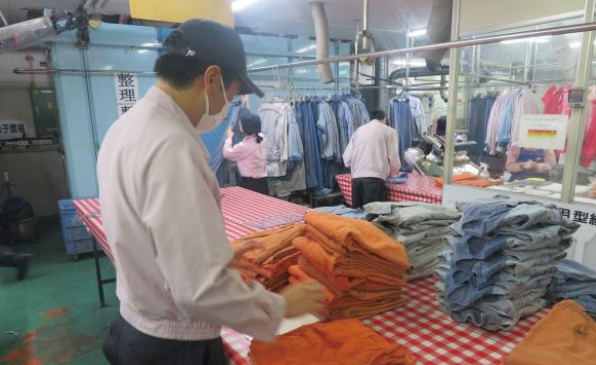
To secure human resources and promote active participation
Amid significant environmental changes, such as intensifying recruitment competition due to the recent decreasing population, diversifying individual career perspectives, and labor market fluidity, the Company believes securing human resources and promoting the further advancement of employees are extremely important to realize our management strategies.
As one of the management priorities, we are implementings various personnel and public relations measures.
In order to secure human resources, In addition to the stable recruitment of new graduates and the recruitment of postdoctoral researchers with a high degree of expertise,the Company is actively recruiting experienced personnel, including alumni. We are also developing public relations measures to increase the awareness of our company among a wide range of generations, not just students seeking jobs. We have also improved the working conditions of employees, including starting salaries.
In order to promote active participation of human resources, the Company is strengthening measures to improve employee engagement through promoting internal dialogue and communication and providing opportunities for mid-career and young employees to challenge and grow, such as sending them abroad. Most recently, we have launched internal recruitments and in-house entrepreneurship as part of the staff reassignment and development measures.
